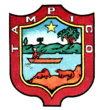Tampico, Mexico
| Tampico, TS | ||
|---|---|---|
|
||
 Location of Tampico within Tamaulipas |
||
 Location of Tamaulipas within Mexico |
||
| Coordinates: 22°15′19″N 97°52′07″W / 22.25528°N 97.86861°WCoordinates: 22°15′19″N 97°52′07″W / 22.25528°N 97.86861°W | ||
| Country |
|
|
| State |
|
|
| Founded | April 13, 1823 | |
| Government | ||
| • Mayor | Magdalena Peraza Guerra (PRI) | |
| Area | ||
| • City | 92.73 km2 (35.80 sq mi) | |
| Elevation | 10 m (30 ft) | |
| Population (2010) | ||
| • City | 297,284 | |
| • Density | 4,338/km2 (11,240/sq mi) | |
| • Metro | 859,419 | |
| • Demonym | Tampican (Spanish: Tampiqueño) | |
| Time zone | Central Standard Time (UTC-6) | |
| • Summer (DST) | Central Daylight Time (UTC-5) | |
| Website | www.tampico.gob.mx | |
Tampico is a city and port in the southeastern part of the state of Tamaulipas, Mexico. It is located on the north bank of the Pánuco River, about 10 kilometres (6 mi) inland from the Gulf of Mexico, and directly north of the state of Veracruz. Tampico is the fifth-largest city in Tamaulipas, with a population of 297,284 in the city proper and 859,419 in the metropolitan area.
During the period of Mexico's first oil boom in the early 20th century, the city was the "chief oil-exporting port of the Americas" and the second-busiest in the world, yielding profits that were invested in the city's famous architecture, often compared to that of Venice and New Orleans. The first oil well in Mexico was drilled near Tampico in 1901 at Ébano.
In 1923, the major oil field dried up, leading to an exodus of jobs and investment, but economic development in other areas made the city a pioneer in the aviation and soda industries. The city is also a major exporter of silver, copper, and lumber, as well as wool, hemp, and other agricultural products. Containerized cargo is mainly handled by the neighboring ocean port of Altamira.
The name "Tampico" is of Huastec origin, tam-piko meaning "place of otters" (literally "water dogs"). The city is surrounded by rivers and lagoons of the delta of the Pánuco River, which was the habitat of a large population of otters. There have been successive human settlements in the area for centuries. The region had several early Huastec settlements, among them the important site at Las Flores, which flourished between AD 1000 and 1250.
...
Wikipedia

